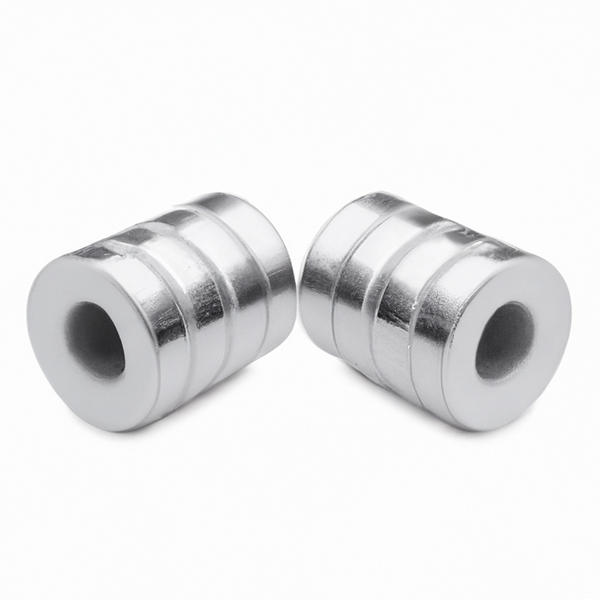
Ring magnets are versatile and can be used in a variety of applications, including scientific experiments, medical equipment, and manufacturing. They are shaped like a ring with a hole in the center and have north and south poles that can be segmented in different ways around the ring.
The unique polarization of ring magnets allows them to work with other components such as rods or tubes, making them useful for holding applications. The north and south poles of ring magnets always alternate around the ring, and they can be segmented into halves, quarters, or even eighths. This versatility makes ring magnets useful for a wide range of applications.
Ring magnets are versatile and useful in a variety of applications due to their unique shape and ability to work with other components, such as rods or tubes. These magnets are characterized by their polarized nature, with the north and south poles segmented in a variety of ways around the ring and alternating with each other.
The segmentation of the poles allows for flexibility in their placement, with the poles able to be located in halves, quarters, or even eighths around the ring. This versatility makes ring magnets an ideal choice for a wide range of applications, including science experiments and medical equipment. Overall, the combination of their shape and polarization make ring magnets a highly useful and versatile tool.
We can custom manufacture Ring magnets to your exact specifications.
There are several ways to produce ring magnets, depending on the specific material and desired properties of the magnet. Here are some common methods for producing ring magnets:
1. Powder metallurgy:
This method involves mixing a magnetic material, such as iron or neodymium, with a binder to form a slurry. The slurry is then shaped into the desired shape, such as a ring, and sintered (heated under pressure) to bond the particles together.
2. Injection molding:
This method involves injecting a molten magnetic material, such as iron or neodymium, into a mold to form the desired shape, such as a ring. The magnet is then allowed to cool and solidify.
3. Bonding:
This method involves bonding together thin sheets or strips of magnetic material, such as iron or neodymium, using an adhesive. The sheets or strips are shaped into the desired shape, such as a ring, and the adhesive is allowed to cure.
4. Machining:
This method involves shaping a block or rod of magnetic material, such as iron or neodymium, into the desired shape using machine tools, such as lathes or milling machines.
5. Casting:
This method involves melting a magnetic material, such as iron or neodymium, and casting it into a mold to form the desired shape, such as a ring. The magnet is then allowed to cool and solidify.
There are several different materials for ring magnets available, each with different properties and characteristics.
Neodymium ring magnets, for example, are made of a rare earth material and come in grades ranging from N30 to N35. These grades refer to the strength of the magnetic field produced by the magnet, with higher numbers indicating stronger magnetic fields.
Ceramic ring magnets are another type of magnet available. These magnets are made of a ceramic material and are available in Grade 5. Ceramic magnets are known for their moderate magnetic strength and are often used in applications that require a lower cost magnet with good magnetic properties.
It is important to choose the suitable material of magnet for your specific application, as different materials have different magnetic properties and may not be suitable for all applications. Factors such as cost, availability, and the required performance of the magnet should be considered when selecting a material.
We provide ring magnets according to your customized requirements.
Ring magnets are versatile and have a wide range of applications. Here are some examples of how ring magnets are used:
Motors and generators:
Ring magnets are often used in electric motors and generators to produce rotational movement and generate electricity.
Sensors:
Ring magnets are used in sensors, such as hall effect sensors, to detect the presence or absence of a magnetic field.
Magnetic separation:
Ring magnets are used in magnetic separation equipment to remove ferrous contaminants from a material stream.
Science experiments:
Ring magnets are often used in science experiments to demonstrate the properties of magnets and the effects of magnetic fields.
Medical equipment:
Ring magnets are used in medical equipment, such as MRI machines, to produce strong magnetic fields for imaging the body.
Toys:
Ring magnets are used in toys, such as magnetic construction sets, to allow children to build and create structures using the attractive and repulsive forces of magnets.
Industrial equipment:
Ring magnets are used in a variety of industrial equipment, such as conveyor systems and lifting magnets, to move and manipulate materials.
Service every customer with care & professional.
Professional Production Base
AEMagnets is equipped with a complete set of advanced equipments and processing facilities in particular high standard cleaning room.
Strict Quality Control - ISO9001
We runs a strict quality control system involving raw materials selection, production control, product inspection, fine packing.
Timely and Attentive Service
We strive to provide fast and efficient service to meet your deadlines and provide full technical and after-sales service support.

